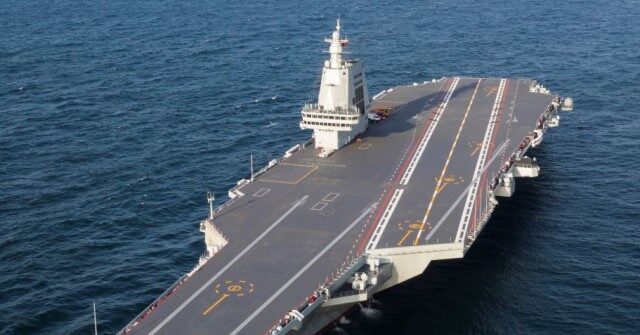We support our Publishers and Content Creators. You can view this story on their website by CLICKING HERE.

The California-based Middlebury Institute of International Studies published research this week that showed China has constructed a prototype nuclear reactor that could fit aboard a large surface vessel – a sign that China is making progress toward building a nuclear-powered aircraft carrier.
At the present time, only the United States and France have nuclear-powered aircraft carriers. The U.S. has 11 of them, while France has one, the flagship Charles de Gaulle.
China has three aircraft carriers, one of them an aging Russian design commissioned in 2012 as the Liaoning. The most interesting of the three ships is the Fujian, launched in 2022 and ominously named for the Chinese province opposite Taiwan.
The Fujian was domestically built and is far more advanced than the other two carriers, approaching the capabilities of America’s carriers in several key respects, although it is considerably smaller than America’s Nimitz and Gerald R. Ford-class ships. One of the Fujian’s most significant features is that it uses catapults to launch planes, as America’s carriers do, instead of the harrowing “ski slope” launch ramp on the bow of China’s older carriers.
The Fujian began sea trials in May 2024. The People’s Liberation Army Navy (PLAN) claims it successfully tested its electromagnetic launch catapults in September 2024. Assuming its tests continue to be successful, it will probably be declared “operational” within the next two years.
Military analysts are now turning their attention to China’s fourth carrier, which has reportedly been under construction since before the Fujian sea trials began. The fourth carrier might well be nuclear-powered. If not, the fifth and sixth could be, since China has announced plans to have six carriers in the water by 2035.
This would be a significant development because conventionally-powered carriers are seen as primarily defensive platforms, while the longer range and extended deployment times possible with a nuclear carrier make them more viable as offensive weapons.
According to the Middlebury Institute of International Studies, China has been working on a nuclear reactor for aircraft carriers at a suspicious facility in the mountains outside Leshan, a city in the southwestern province of Sichuan.
Middlebury’s researchers originally suspected the Leshan facility might be a reactor for producing weapons-grade plutonium or tritium. Using satellite images, plus data such as project requisitions for equipment, personnel files, and environmental impact studies, the Middlebury Institute determined it was more likely that the facility is a prototype nuclear reactor for a large surface vessel.
Among other evidence, researchers noted the site is controlled by the Nuclear Power Institute of China and some of its requisitions for equipment were issued by a unit called the 701 Institute, which is devoted to developing aircraft carrier technology.
Several documents indicated the Leshan project was for “national defense,” increasing confidence that the project is developing nuclear-powered aircraft carrier technology.
“Unless China is developing nuclear-powered cruisers, which were pursued only by the United States and the Soviet Union during the Cold War, then the Nuclear Power Development Project most certainly refers to a nuclear-powered aircraft carrier development effort,” the Middlebury Institute said.
Some analysts question whether China really needs a nuclear-powered aircraft carrier for any reason other than national prestige and bragging rights. China’s naval strategy primarily concerns itself with dominating three strategic island chains, the first of which encompasses the South China Sea, the Philippines, and Taiwan.
Conventionally powered carriers, supported by China’s vast infrastructure of shore and island missile batteries and airfields, are sufficient to meet those objectives. Spending vast sums on developing a nuclear carrier seems like wasted effort, especially since the PLAN still has a way to go before its conventionally-powered carriers can match the U.S. Navy.

 Conservative
Conservative  Search
Search Trending
Trending Current News
Current News 







